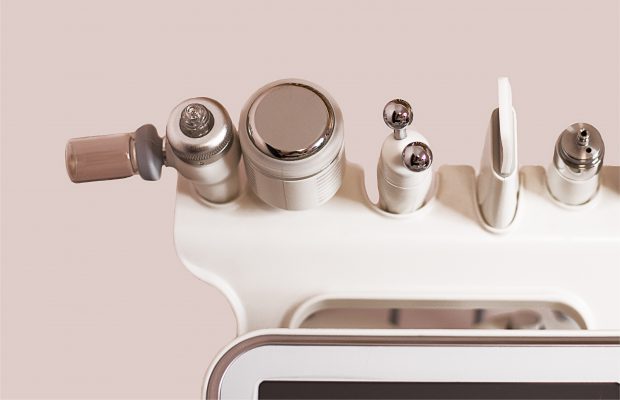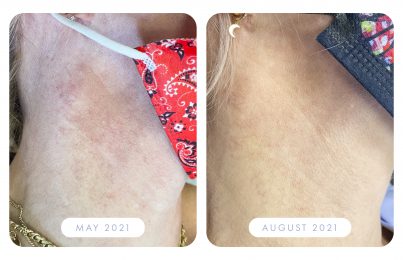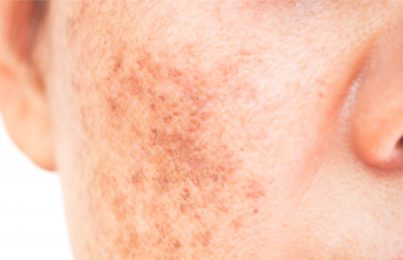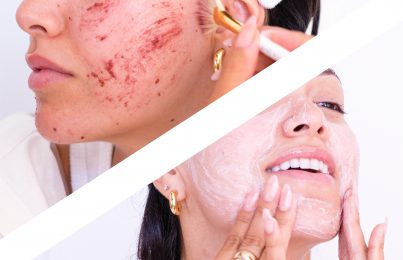Updated 08/15/23. Sun damage can happen year-round, but it’s normal to notice it in the fall after you’ve spent a whole summer enjoying the great outdoors. While daily sunscreen application and an effective at-home skincare routine can make a big difference in the state of your skin, sometimes, professional treatments are needed. These treatments can target the more stubborn signs of sun damage for quick results.
In this post, I’ll detail the best professional treatments for sun damage with help from Board-Certified Dermatologist Dr. Marisa Garshick. Ready? Let’s go!
What Exactly Is Sun Damage?
The first thing you should know is that sun damage can manifest in many different ways. In fact, the term doesn’t define a specific condition—it’s more like an umbrella for multiple conditions. According to Dr. Garshick, “Sun damage can appear in many different ways and can result from cumulative exposure to the sun over many years or even in the setting of recent exposure, such as at the end of the summer.”
When most people think of sun damage, they think of brown spots and hyperpigmentation. These are certainly common signs, but there are others, too. “Other changes that can be seen as a result of sun damage include broken blood vessels or telangiectasias of the skin, rough sandpaper-like spots known as actinic keratoses, as well as changes in the texture of the skin, with fine lines and wrinkles as well as crepiness,” Garshick explains.
There’s also Poikiloderma, which is a skin condition that includes both hyper and hypopigmentation, broken blood vessels, and skin thinning due to cumulative sun exposure. Fun fact: I actually have Poikiloderma on my neck, and I go in for regular laser treatments to help fade it. You can read all about that here.
How Can You Address Sun Damage at Home?
The first thing you should do when creating an effective at-home skincare routine for sun damage is to use products formulated for your specific skin type. (Take the Skin Type Quiz to find out which Renée Rouleau Skin Type you belong to. If you have a lot of visible sun damage, you may be a Skin Type 8.)
When it comes to the types of products you should use, both Dr. Garshick and I recommend the same ones.
1. Wear Sunscreen
The first is sunscreen—no surprise there! Sunscreen is hands down the best anti-aging product on the market, and there’s nothing better for minimizing sun damage. Make sure you’re using one that’s lightweight and won’t clog your pores. I recommend Weightless Protection SPF 30. It’s the sunscreen I wear every single day!
“Even if the damage is already there, you should continue to use sunscreen to prevent further damage,” Garshick says. “In general, it is recommended to use SPF 30 or higher and remember to reapply every 2 hours. With people spending more time at home, we are learning more about the effects of blue light on the skin, which research is showing may lead to signs of aging, hyperpigmentation, and fine lines and wrinkles. As such, it may be important to seek out products that also protect against blue light as well as use protection on our screens, such as EyeJust Blue Light Blocking Screen Protector.
Note: the mineral ingredients found in makeup can help protect against visible light (including blue light). It’s just one of the reasons why I recommend wearing makeup every day!
2. Use Retinoids
Retinoids, including retinol, are incredibly effective at targeting sun damage since they boost cell turnover, helping to improve overall tone and texture with time. Garshick notes that they also stimulate collagen production, which can help with fine lines and wrinkles. Trust me—if you have sun-damaged skin, and you’re not already using retinol, you should be!
I recommend the Advanced Resurfacing Serum to all of my clients. I formulated it to be safe for sensitive skin types, so you don’t have to worry about excess dryness and irritation.
3. Use Antioxidants
Antioxidants, like vitamin C, are fantastic brightening ingredients. In fact, I recommend using a vitamin C serum every single morning to keep your skin tone nice and even. That’s not the only benefit they provide, though. “Antioxidants can help to neutralize free radical damage which can contribute to the appearance of sun damage, so using antioxidants, such as vitamin C, can help protect against DNA damage,” Garshick says.
4. Use Both Chemical and Physical Exfoliants
If you’re a regular reader of my blog, you know how much I recommend incorporating exfoliating acids into your skincare routine. They encourage cell turnover and dissolve and digest the “glue” that holds dead, pigmented cells together. Translation? They can smooth, brighten, and even out sun-damaged skin.
When it comes to sun damage and hyperpigmentation specifically, I recommend a 2-step approach to exfoliation. Start with a chemical exfoliant (like an at-home chemical peel or an exfoliating acid serum) and follow up with a gentle physical exfoliant (like a facial scrub). The chemical exfoliant will break up pigmented cells and the physical exfoliant will lift them away.
What Are The Best Professional Treatments for Sun Damage?
As I mentioned before, if you have a lot of sun damage (for example if you’re a Skin Type 8) you could benefit from certain professional treatments. Of course, you’ll have to consult a trusted skincare professional, such as an esthetician or a dermatologist for these, but they can make a major difference in the state of your skin!
1. Fractional Laser Treatments
Fractional laser treatments can be incredibly effective at minimizing the appearance of sun damage. Take it from Garshick, who says, “These treatments can help with brown spots, discoloration, fine lines, wrinkles, and skin laxity, which can all be a result of sun exposure. Although there is some downtime associated with these procedures (on average 3-7 days), these provide great results to improve the appearance of sun damage and allow for a reset. While you will see results even with just one treatment, it is often recommended to do multiple for best results.”
Fractional laser treatments work by triggering the wound-healing process, thus boosting collagen production and improving skin tone and texture. Garshick says the word “fractional” means that the laser doesn’t affect all areas of the skin. This helps speed up the recovery process.
2. Intense Pulsed Light (IPL)
The second expert-recommended treatment for sun damage is Intense Pulsed Light (IPL), which is also known as a photofacial. This is a treatment I’m extremely familiar with since I get it semi-regularly for my poikiloderma.
According to Garshick, this is a type of light therapy, but it differs from laser treatments. “It is different from a laser which emits a single wavelength, as this light-based therapy uses multiple different wavelengths. As such it is often able to target redness and broken blood vessels as well as brown spots and discoloration. While there is not much downtime expected with this treatment, it is possible to notice an initial darkening of dark spots and some potential worsening of redness which subsequently improves within a few days.”
3. Chemical Peels
The benefits of chemical peels, especially for sun damage, can’t be overstated. As an esthetician with over 30 years of experience, I’ve performed countless chemical peels. I’ve seen firsthand how they can change the skin for the better. They resurface the skin, so they help lift hyperpigmentation, smooth texture, and brighten overall tone.
“Chemical peels work by getting rid of dead skin cells and helping to stimulate skin cell turnover which helps improve skin tone and texture, while also stimulating collagen production,” Garshick says. “The deeper the peel, the more downtime can be expected, with medium-depth peels being a good option for those with a lot of sun damage. The more treatments, the better the results but it is important for those with darker skin types to be cautious given the risk of potential hyperpigmentation.”
There are different types of chemical peels. Consult a trusted skincare professional to find out which one is best for you.
4. Microneedling
Last but not least, there’s microneedling. This treatment is great for sun damage. It uses tiny needles to create small puncture wounds in the skin. The purpose of creating these micro-wounds is to trigger your skin’s own healing response, which is pretty powerful. It might sound scary, but microneedling is associated with little to no pain, and a topical numbing cream is applied before a single needle ever touches your face. The procedure is done using a tool called a dermaroller, and needles usually range anywhere from 0.5-3.5 mm in length.
Garshick says it can improve the appearance of fine lines and wrinkles, uneven texture, and hyperpigmentation. “The addition of platelet-rich plasma (or PRP) may make the microneedling even more effective as the PRP is thought to contain growth factors to help speed the healing process and promote skin cell renewal. Generally, I recommend at least 3 sessions to see improvements, though even just one will show improvement.”
It’s not just sun damage that this treatment works well for. It also works well for post-breakout marks and indented acne scars.
The Bottom Line
It’s always easier and less expensive to prevent sun damage than it is to deal with it after the fact. That’s why proper sun protection is critical. Make sure you’re applying SPF every single day, wearing sun-protective clothing, and seeking shade whenever possible.
However, if your sun damage is already apparent, it doesn’t mean you’re powerless. Start practicing proper sun protection, use the right at-home products, and consult a trusted skincare professional to ask about the aforementioned professional treatments. If you do all of these things, your skin will look and feel smooth, bright, and youthful!
Next, read up on everything you need to know about melasma.
Celebrity Esthetician & Skincare Expert
As an esthetician trained in cosmetic chemistry, Renée Rouleau has spent 30 years researching skin, educating her audience, and building an award-winning line of products. Her hands-on experience as an esthetician and trusted skin care expert has created a real-world solution — products that are formulated for nine different types of skin so your face will get exactly what it needs to look and feel its best. Trusted by celebrities, editors, bloggers, and skincare obsessives around the globe, her vast real-world knowledge and constant research are why Marie Claire calls her “the most passionate skin practitioner we know.”




Comments:
Really Nice! Very useful information in this blog! Thanks for sharing with us!
Posted By: Urist Cosmetics Inc |